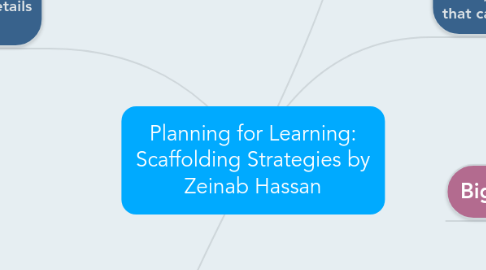
1. What is Scaffolding Strategies?
1.1. The Moon
1.2. The Sun
1.3. The Earth
2. Big Idea 1
2.1. The Earth exists in a system of moving objects that are connected in space. These objects have physical characteristics that impact our daily lives. The Earth revolves around the sun while the moon revolves around the Earth.
2.2. The interaction and changes in the moon and sun determine the availability of light and heat. The stars are always in the sky but the light from the sun makes them invisible in the daytime.
3. Common Core standards: CCSS.ELA-Literacy.RL.1.1 Ask and answer questions about key details in a text.
3.1. Objective 1: Students will be able to answer questions after reading the Disappearing moon by Dori H. Butler. These questions will show students' level of understanding of the phases of the moon
3.1.1. Scaffolding strategies for students reading below grade level
3.1.1.1. 1. Provide book instruction to assess prior knowledge
3.1.1.2. 2. Have students in a circle setting on the carpet during the question period
3.1.1.3. 3. Select and teach important vocabulary words to build understanding
3.1.1.4. 4. Allow self-monitoring of comprehension by asking questions to each student one at a time. If students not able to answer, give him/her a clue.
3.2. Objective 2: Students will be able to describe the physical properties and patterns of the Earth, Moon, Sun and other stars by reading the text Earth, Moon, Sun and stars by Alyse Sweeney.
3.2.1. Scaffolding strategies for students reading at or above grade level
3.2.1.1. 1. Provide students with explicit academic goals and direct instructions on how to achieve them.
3.2.1.2. 2. Use concept and mind maps to allow students to present their ideas about the celestial bodies and patterns.
3.2.1.3. 3. Allow students to work in pairs or small groups
3.2.1.4. 4. Allow students to read and retell important details and facts about the moon, stars and earth.
4. References
4.1. 1. http://www.nextgenscience.org/dci-arrangement/1-ess1-earths-place-universe
4.2. 2.http://www.nextgenscience.org/sites/default/files/evidence_statement/black_white/MS-ESS1-1%20Evidence%20Statements%20June%202015%20asterisks.pdf
4.3. 3. https://www.opened.com/search?offset=0&standard=1.ESS1.1
5. Next Generation Science Standards (NGSS): Earth's Place in the Universe 1-ESS1-1.Use observations of the sun, moon, and stars to describe patterns that can be predicted.
5.1. Objective 1: Students will model the phases of the moon by using the frosting from Oreo® cookies
5.1.1. Scaffolding strategies for student(s) with intellectual disability
5.1.1.1. 1. Tap into students' prior knowledge in order to determine his/her current understanding of the concept presented.
5.1.1.2. 2. Use Visual aids (videos, pictures, short movies and songs) to demonstrate the different phases of the moon
5.1.1.2.1. Moon phases song
5.1.1.2.2. Phases of the moon (picture)
5.1.1.3. 3. Model the task and provide a complete guided practice
5.1.1.4. 4, Ask students continuously if they have any questions or need any clarification
5.1.1.5. Repeat task as needed for a better understanding
5.2. Objective 2: Students will be able to compare and contrast the sun and the earth by completing observations using a Venn diagram, writing phrases in their journals and creating models of each.
5.2.1. Scaffolding strategies for a student with a language or speech disorder
5.2.1.1. 1. Use advance organizers to introduce, contrast and compare the concept presented
5.2.1.2. 2. Pre-teach vocabulary and key words through pictures, images and visual aids
5.2.1.3. 3. Provide students with additional time to answer and to form their sentences.
5.2.1.4. 4. Allow students to participate in "Think, Pair and Share"
5.2.1.5. 5. Provide students with cue cards to develop the sentences that are related to the context. These sentences can be used in their science journal.
